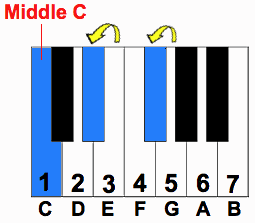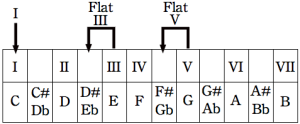Diminished Chords have a unique sound all their own. They are very dissonant and have a mysterious unique sound. When I first learned to play this chord I thought it sounded a little unnatural, like it wouldn’t fit right in a song.
They do have a place in a lot of songs though. They can be a great transition chord, and also give a song a unique sound.
We are going to talk about how to build, play, and recognize this piano chord in music.
So let’s get started!
What is a Diminished Chord?
These piano chords are diversions of a major chord, and can easily be made by first building a major chord. The major chord is made up of the firsts, third, and fifth notes in the major scale.
In the key of C the notes would be: C, E, F
To make a chord diminished, you need to turn the major chord into a minor chord.
If you remember from our lesson on minor chords, you can easily make one by moving the third note in the scale down one half-step.

With the third note moved down, you have a minor chord with the notesC, Eb, and G.
Now that you have a minor chord, to finish the chord, just lower the fifth note in the scale down one half step to get a diminished chord.
The notes in this chord are now C, Eb, and Gb.
The easiest way to make diminished chords is to take the fifth and third notes in the scale and move them both down one half-step.

Take a look at the image above, and you can see how we found the third and fifth note in the key of C, and the lowered them a half-step. We moved from a major chord, to the a diminished in two easy steps!
Diminished Formula
You can make a simple formula to remember the notes in this chord. Simply number the notes in the scale like in the chart below. We put a Roman Numeral for each note in the key of C.

To create diminished, keep the root note, or Roman Numeral I the same. Then use a flat III (bIII), and lastly a flat V (bV).
You can see in the image that we are moving from the III and V to the note directly to the left.
This tells us the formula is: I – bIII – bV
Using this formula can make building a diminished chord a lot easier. If you want to make the chord in keys other than the key of C, you can use the formula to make it a lot easier.
Even if you don’t know the notes in the scale, just remember to flat the third and the fifth note of the major chord and you will have a diminished chord.
How It’s Played
The fingering for this piano chord is identical to a major chord.
You will use the first finger on the root note. In this case it is on C.
The third finger will be on the E flat, and the fifth finger will be on the G flat.

It makes it a whole lot easier to play this chord because the fingering is identical to a major chord. Slide your fingers one note directly to the left and you are note right notes
Sheet Music
Take a look at the image, and see how this chord looks on a piece of sheet music.
As you can see, there are two flats in this chord. This is where we get lowering the third and fifth note in the major chord.
 |  |
If you compare the major and diminished, you will see that they are made up of the same notes C, E, G.
The only difference here, is that the diminished has the two flats on the top two notes. This is where the comparison to the major chord comes into practice.
Almost all chords can be built off of the major chord. If you can build a major chord you can build just about any piano chord. If you learn the formula for each chord, you can make just about any chord you want.
Let’s listen to this chord in action. The chord sounds a little strange. It is very mysterious sounding.
Listen to the dissonance in Diminished Sounding Chords.
Where To Use It?
I love using this chord as a transition chord. It can easily be used as a walk up chord from a V chord to a minor VI chord.
If you don’t understand the numbers, let’s talk about what it means.
Let’s say we are in the key of C. The fifth chord in the key of C is a G major.
If the chord chart asks you to play an A minor directly after a G major, you can use Diminished Chords to transition between the two.
Between the G major and A minor, add an A flat Diminished to give it a walk up feel.
This is a great way to add a little flare into a song. And it is really easy too!
If you noticed, all you had to do was move your thumb up one half-step to transition between the G major and the A flat diminished.
Take a look at the image to see what it looks like on sheet music.

You can use this walk-up in any key. Start on the V chord in the scale, move you thumb up one half step, and then end on the minor VI chord. This works every time!
Diminished Chords Symbols
There are two main ways to express diminished chords, with the standard dim, and also with the less common o.
The dim is used more commonly then the o, but both can be used interchangeably.
An Edim chord and and Eo chord are both identical piano chords. They both represent a diminished chord.
Make sure that you are able to recognize both of these symbols and that you now that both of these mean the same chord.
Diminished Chords have a different sound, and aren’t used as often as other chords. They are very useful to know and can create neat sounding chord progressions.
Make sure to get familiar with these chords in all the different keys.
Need more help learning chords? Learn almost every chord you’ll ever need with our Piano Chord Encyclopedia.
Go From Diminished Chords Back to Piano Chords
Back to Home Page

